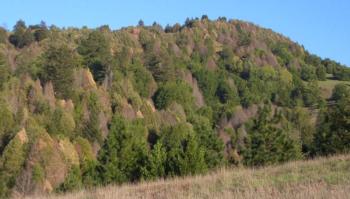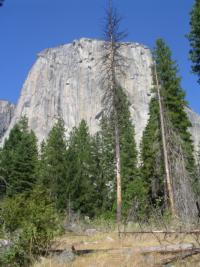Research in the Rizzo lab focuses on the ecology and management of exotic and native forest tree diseases, primarily in California ecosystems. We take a multiscale approach, with projects ranging from experimental studies of basic organism biology to landscape-scale field surveys. Many projects in the lab include active collaborations with molecular biologists, landscape ecologists, epidemiologists, entomologists, and forest managers.
Our current research in our lab focuses on invasive Phytophthora species in ecological restoration sites stemming from infected nursery stocks. Our continuing research focuses on aerial Phytophthora species in California coastal forests, with an emphasis on Phytophthora ramorum, the causal agent of Sudden Oak Death (SOD).

Tanoak mortality due to SOD
In California, millions of trees have died due to
P. ramorum infection since the introduction of this pathogen in the mid-1990s. Our study sites span the range of
P. ramorum infestation in California, from
Big Sur to the Oregon border, and include
long-term monitoring plots that encompass a diversity of forest types, including: redwood-tanoak, Douglas-fir-tanoak, coast live oak, and mixed oak woodlands. Across this range, we are studying the ecology of the pathogen and monitoring the establishment, spread and ecological impacts of SOD.
Many Phytophthora species have swept through California nursery stocks. Through the accidental infestation of nursery stock, many restoration ecology sites that are looking to benefit local habitats end up spreading more invasive pathogens in the area. Once Phytophthora species have established residence in an ecosystem, they are incredibly difficult to nearly impossible to remove.

Root disease mortality center in Yosemite Valley
Previous research projects in our lab focused on the role of native and exotic pathogens in conifer forests of the Sierra Nevada and other interior mountain ranges of Northern California. These projects examined a variety of diseases and their relationship to past and present forest management and conservation issues.
White pine blister rust is an exotic pathogen that threatens white pine diversity in mixed-conifer and subalpine forests. Our research team took an ecological and genetic approach to better understand the interactions of disease pressure, environment, and evolutionary processes on the population dynamics of white pine species in California. In the mixed-conifer forests of Yosemite Valley and the Teakettle Experimental Forest in the southern Sierra Nevada, we had projects examining the influence of multiple pathogens and insects on forest structure and development in the context of various land management practices, including fire, thinning, and multiple land-use practices.
We also deal with fungal and oomycete pathogens concerning almonds and other stone fruits.



